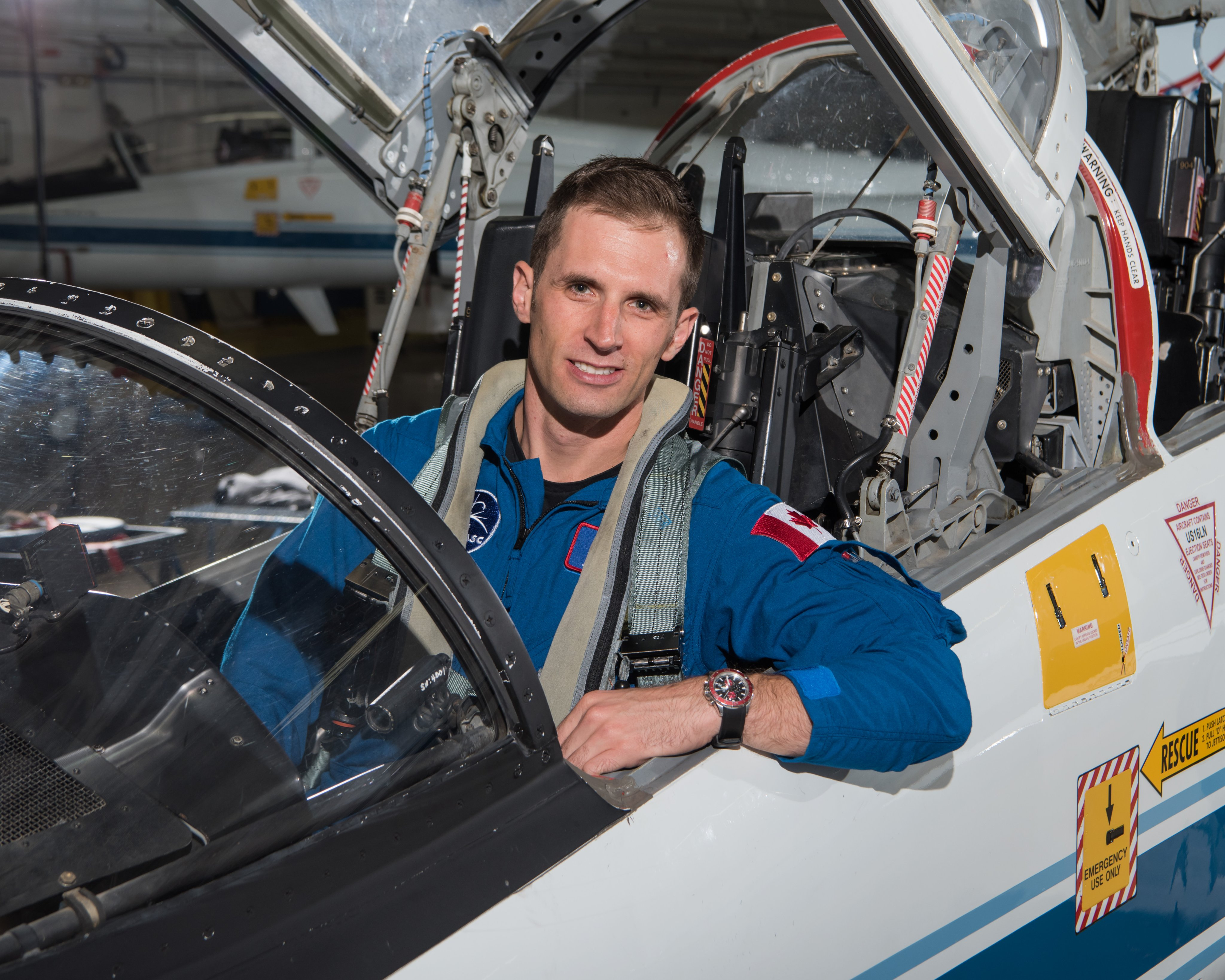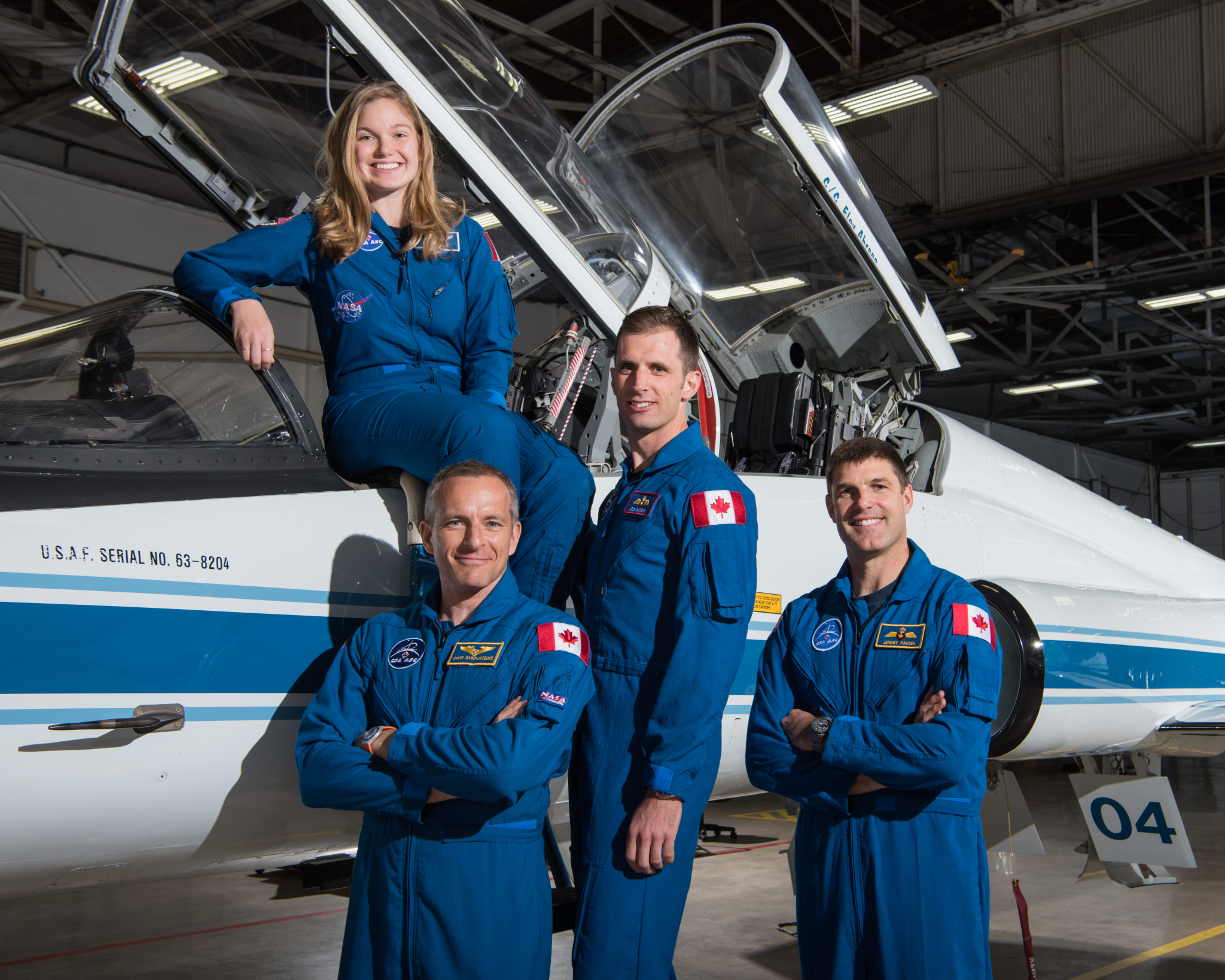
MONTREAL, CANADA — Freezing rain and foggy air couldn't dampen the Canadian space spirit.
"Whoops" and cheers filled the glass-ringed Canadian Space Agency (CSA) lobby in Longueuil on Nov. 22 as an excited audience glimpsed astronauts Jenni Gibbons and Josh Kurtryk, clad in classic blue flight suits, emerging from a hallway. Already, it was worth braving the difficult driving conditions here. The cameras weren't rolling yet, so we knew before the world did that these rookie astronauts finally had their space assignments.
"Look at the energy in the house. Look at that!" François-Philippe Champagne, the Canadian cabinet minister responsible for the CSA, exclaimed as the crowd continued to cheer on camera. CSA has a small government budget relative to superpowers like NASA or the European Space Agency, but Gibbons' and Kutryk's smiling faces — enhanced by the energy echoing through the glass lobby — demonstrated what could happen for the agency with the last six years of smart funding since the astronauts' 2017 selection.
"It's exactly where I want to be, and I'm also proud of the fact that Canada and the Canadian Space Agency is there," Kutryk told Space.com. Kutryk got a seat on an International Space Station (ISS) mission in 2025, thanks to CSA receiving government funds earlier this year for new station missions between 2025 and 2030.
Related: Canada assigns astronauts to launch on Boeing's Starliner, back up Artemis 2 moon mission
Kutryk, a colonel and former test pilot for the Royal Canadian Air Force, will now redirect his experience to test out the Boeing Starliner-1 spacecraft in orbit on its first operational mission to the ISS. (The CSA typically receives long-duration missions about every six years thanks to its contributions of Canadarm2 and Dextre robotics to the ISS, representing 2.3% of the multinational partnership.)
Gibbons will be backup for the Artemis 2 mission; a historic effort that will hopefully bring four humans to the moon's orbit in 2024, including CSA astronaut Jeremy Hansen. Hansen's lunar seat comes from a different pool of Artemis Accords funding fueled by the new CSA robotic arm meant for moon exploration, called the MDA-built Canadarm3. Canadarm3 will more specifically be important for NASA's planned Gateway space station, designed to function as a science outpost in lunar orbit.
Again, the financial commitment for Canadarm3 is big for Canada. The multiphase contract is worth more than $1 billion Cdn ($730 million USD) spread out over 15 years, which is quite a large spend for a country of just 40 million people. In March 2023, Canada also allocated $1.43 billion Cdn ($1.05 billion USD) of moon funding across a few years, including a lunar utility vehicle for astronauts on the moon and a set of Canadian science components on Gateway.
"My role as a backup will be to support that mission in any capacity that's needed," Gibbons told Space.com of Artemis 2. Aside from communicating with Hansen and the crew when they fly to the moon, she will serve as "a test subject for all of the operations on the ground, from looking at launch to splashdown recovery. All of those require multiple tests, so I'll be able to take part in that."
To be sure, Canada has sent many government-funded astronauts to space since Marc Garneau's debut space shuttle mission in 1984 — nine people across 17 missions, according to CSA statistics. As a group, CSA astronauts have spacewalked, commanded the space station and operated Canadarms in space. (Canadians have also flown to space via other venues, to be sure, such as by self-funding pricey space tourism missions and successfully joining the NASA astronaut corps.)
Yet the new missions add an extra edge for CSA, as both Boeing's Starliner-1 and Artemis 2's Lockheed Martin Orion spacecraft are relatively new vehicles for humans. This milestone means Canada has a front seat to setting the stage for astronaut training in the coming years. In fact, Kutryk will be the first CSA astronaut to fly aboard any U.S. commercial spacecraft. Hansen — or Gibbons, as the case may be — will also be the first non-American to leave low Earth orbit, plus fly on Orion.
These astronauts, therefore, "play a very important role in not only defining the training that they're going through, but also making sure that future crews will benefit from their experiences. It's really a critical role," Mathieu Caron, director of CSA's astronauts, life sciences and space medicine division, told Space.com.
Kutryk, for example, has been serving with the Starliner team since 2021, and is using his test pilot background to help problem-solve ongoing technical issues with the Boeing spacecraft. When the first astronaut test mission gets off the ground in 2024 or so, Kutryk will be capcom during the critical ascent and re-entry phases for Starliner's debut crew. Then, his mission, Starliner-1, will be next to fly.
Related: Artemis 2's Canadian astronaut got their moon mission seat with 'potato salad'

While Canada has numerous urban centers within 200 miles (320 km) of the United States border, populations rapidly disperse into tiny towns or small hamlets as one travels north. At this snowy time of year, some communities are only easily accessible by plane. Indigenous communities, for example, depend on satellites and remote medical care.
Funding space, the CSA argues, is one of several ways in which to offer solutions for remote living — hence the extra government money that has recently gone towards deep space health tech, or portable food for moon missions. And climate change can be tracked in large part by satellite, allowing researchers to see from afar which areas are in most need of help against flooding, fire or food insecurity.
"When Josh and I were recruited six years ago, we already understood the importance of the space station for Canada. And we believed in it," Gibbons told the assembled attendees in a speech. "This brings Canadians together, allowing us to make progress on difficult problems facing our country."
Related: Artemis 2 moon astronaut says crew is ready for ambitious 2024 mission

There are also the space-facing Canadians building hubs of their own around the country.
One example is Gordon Osinski, a crater expert who serves as director of the Canadian Lunar Research Network at Western University in London, Ontario, west of Toronto. Osinski was recently the only Canadian named to the Artemis 3 geology support team, following years of work in which he helped build up Western's space capabilities to encompass other departments and partner with different institutions. He also is principal investigator of Canada's Canadensys-built, mini lunar rover expected to land on the moon in 2026.
Osinski periodically runs expeditions to Canada's north with the CSA astronauts to provide on-site geology training as well as the coveted "remote expedition" experience all space explorers need in preparation for space living. His work is so well-regarded now that NASA has Oz (as the community calls him) do basic geology training for all astronaut classes.
Osinski told Space.com that the current pace of space announcements is "probably the most exciting time we've had for the Canadian space program," but he said the community needs to keep up the momentum. For example: Hansen's moon announcement was in April 2023, and Osinski urges Canadians to keep discussing the mission — in scientific and similar forums — through late 2024 and beyond, as the science results come in.
"If nothing else happens in those two years, it's easy to lose sight of what's going on," Osinski said of the need for science activities associated with Artemis 2. The same would be true of other Canadian space work — not only with regard to ISS, lunar rover and Artemis 3 contributions, but also concerning findings coming from the OSIRIS-REx sample return mission from asteroid Bennu, and recent funding to expand and renew the Canada's Radarsat satellites key for Earth observation.
"Every year for the next few years, something really big is happening" in Canadian space, Osinski said. He joked that any schedule changes may be difficult for his team, which does multiple space projects at once: "Hopefully, it will all end up not being in the same year.
"If it does delay, my mind just might explode."







